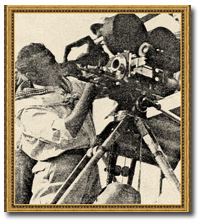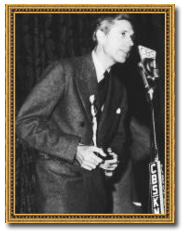
 |
Hal
Wallis (1898
- 1986) -- Producer.
One of the greats of the Golden Age of Hollywood. Wallis entered the
movies as a theater
manager, joined Warner Brothers' publicity department, and soon became
studio manager and later production executive. The movies he produced
for Warner Brothers make an impressive list of some of the greatest
films of that studio. They include Little
Caesar (1930),
with Edward G. Robinson, I
am a Fugitive from a Chain Gang (1932), with
Paul Muni, 42nd Street (1933),
with Warner Baxter,
The Adventures of Robin
Hood (1938), with Errol Flynn, Sergeant
York (1941),
directed by Howard Hawks and starring Gary Cooper, the classic The
Maltese Falcon (1941) with Humphrey Bogart, and Now,
Voyager (1942)
with Bette Davis and Paul Henreid.
Wallis was active in films up until the mid 1970's, producing some
memorable films outside of the studio system and free of the restraints
of the Production
Code. |
 |
Michael Curtiz (1888 - 1962) -- Director. He was not an influential stylist such as Orson Welles, or a consecrated auteur like Howard Hawks. He neither had the stylish touch of Alfred Hitchcock, nor the maverick, fighting spirit of John Ford. And yet, Michael Curtiz's talents go far beyond that of the journeyman status he earned in his lifetime, and which still reduces him to a level below those directors mentioned above. Curtiz could direct films in any genre, and his long list of films proves it. For starters, he was involved in the production of over forty silent films in his native Hungary and Germany before coming to the United States. He truly excelled in every genre: pirate films, Captain Blood (1935) and the Sea Hawk (1940), gangster films, Angels with Dirty Faces (1938), westerns, Dodge City (1939) and The Santa Fe Trail (1940), and even Oscar®-winning musicals such as Yankee Doodle Dandy (1942). He directed many of his films for Warner Brothers, and Hal Wallis was his producer in some of the best and most memorable ones. |
 |
Arthur
Edeson (1891
-1970) -- Director of Photography. One of the great Hollywood
cinematographers, Arthur Edeson was a film pioneer who started in
silent films, made an incredibly successful transition into talkies,
and was active in film for four decades. He was the cinematographer
on most of the great Douglas Fairbanks films, including Robin
Hood (1922) and The
Thief of Bagdad (1924). As early as 1925, Arthur Edeson showed
a penchant for horror films and he was selected to be the cameraman
in the ground-breaking The
Lost World (1925). In
the early days of the talkies, Edeson shot a number of important
horror films for
Universal including Frankenstein (1931), The
Old Dark House (1932), and The
Invisible Man (1933), all directed by James Whale. For
Warner Brothers he photograped Satan
Met a Lady (1936) an early version
of Dashiell Hammett's The
Maltese Falcon as well as the 1941 version
of that classic story. Incredibly enough, Arthur Edeson never won
an Oscar®, although he was nominated for In
Old Arizona (1929), All
Quiet on the Western Front (1930), and
Casablanca (1942). |
 |
Max
Steiner (1888 - 1971) -- Composer.
The career of composer Max Steiner is a textbook that illustrates
the development
of movie music.
Steiner is undoubtedly one of its architects, and one of its most influential
talents. The list of American films scored by this musical genius,
who was born in Vienna, is impressive and includes King
Kong (1933), Of Human
Bondage (1934), the first film to be shot in Technicolor, Becky
Sharp (1935), the original A
Star is Born (1937), the memorable Jezebel (1938),
as well as Dark Victory (1939),
Gone With the Wind (1939),
They Died With their Boots
On (1941), Arsenic and
Old Lace (1944), The
Treasure of the Sierra Madre (1948) and dozens
of others too numerous to mention. Max Steiner won three Academy Awards® and
received nominations for eighteen other films. His career in Hollywood
spanned fifty years, and his magnificent efforts produced some of the
best known movie music of all time, and set a standard for generations
of composers. |
 |
Howard Koch (1902 - 1995) -- Screenwriter. Among the many films that Howard Koch wrote or co-wrote are The Sea Hawk (1940) directed by Michael Curtiz, his great adaptation of W. Somerset Maugham's play The Letter (1940) directed by William Wyler, In This Our Life (1942) directed by John Huston (his assignment right before Casablanca), and the memorable Letter from an Unknown Woman (1948) directed by Max Ophüls, and starring Joan Fontaine and Louis Jourdan. Howard Koch's career suffered greatly when he was blacklisted in the 1950's. For example, in The Intimate Stranger (1956), a film directed by Robert Losey, he had to use the pseudonym Peter Howard in order to get his work on the screen. Mr. Koch lived long enough to witness the transformation of Casablanca from a run-of-the-mill studio picture to a classic film, beloved and acclaimed the world over. The last interview Howard Koch gave was over the Internet. Click here in order to read the transcript of that great event. |
 |
Julius
J. Epstein (1909
- 2000), Philip
G. Epstein (1909 - 1952) --
Screenwriters.
The great twins were a staple of Hollywood for many years, and the co-writers
of some of the great films of the Golden Age. Among
the films that the brothers wrote together are Daughters
Courageous (1939) and Four
Wives (1939) both directed
by Michael Curtiz. The list also includes The
Man Who Came for Dinner (1942), Mr.
Skeffington (1944), Arsenic
and Old Lace (1944), The
Last Time I saw Paris (1954), and The
Brothers Karamazov (1958). Julius outlived his brother by many years,
and was active in film until the early 1980's. In 1983, Julius J. Epstein
wrote Reuben, Reuben starring
Tom Conti and Kelly McGillis becoming one of the oldest screenwriters
active in movies. In 1995, Mr. Epstein joined Howard Koch for an online
interview which you can read here. Brothers
Julius and Philip were awarded the Academy Award® for their contribution
to the script of Casablanca. |
Go
back to Vincent's "CASABLANCA" HomePage
|